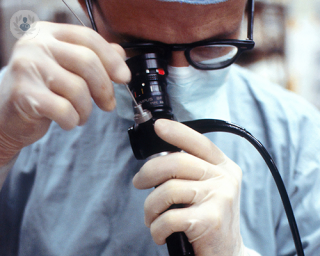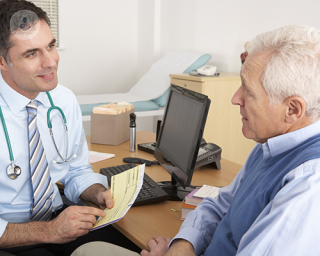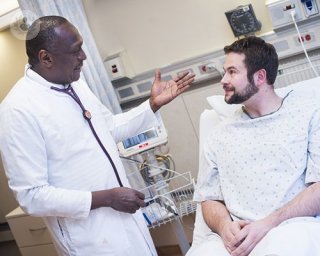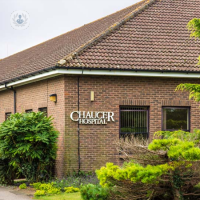What is a gastroscopy?
A gastroscopy is a clinical diagnostic test. Using a thin tube (an endoscope), the inside of the oesophagus, the stomach and the first part of the small intestine (the duodenum) can be visualised. The tube has a light and a camera on the end which sends images to a monitor during the investigation. Hence, a gastroscopy might be used to diagnose conditions related to the oesophagus, stomach, and duodenum.

What does a gastroscopy consist of?
A gastroscopy is performed with an endoscope, which is a thin flexible tube with a small camera at the end and, in some cases, light. This camera aims to obtain images of the inside of the oesophagus, stomach and duodenum.
The procedure lasts around 15 minutes and the tube is inserted through the mouth and it is guided down the throat into the oesophagus and then stomach. The procedure is not painful, but a numbing spray may be used to numb the throat slightly before the tube is inserted.
Why is a gastroscopy done?
A gastroscopy would be done to look for abnormalities in the stomach and duodenum. You can obtain tissue samples for biopsies, remove polyps or determine the presence of some bacteria, such as the bacteria H pylori, which causes many peptic ulcers. During the gastroscopy procedure, bleeding ulcers can also be cauterised.
How should you prepare for a gastroscopy?
In the weeks leading up to a gastroscopy, you may be instructed to stop taking certain medications. The stomach must be empty; you should avoid consuming solid food from the previous night and you can only drink water. It is important, too, not to smoke before the test.
How does it feel during a gastroscopy?
The scan does not usually cause pain. However, it does cause a feeling of nausea that occurs when the tube is inserted through the throat, but a numbing spray can be used to make this less uncomfortable.
What are the main risks associated with a gastroscopy?
Gastroscopy is very safe, but potential side effects could include mild abdominal pain. Other more serious side effects are, for example, the perforation of some organs, haemorrhages, infections and possible allergic reactions.
11-13-2012 06-07-2023Gastroscopy
Dr Devinder Bansi - Gastroenterology
Created on: 11-13-2012
Updated on: 06-07-2023
Edited by: Conor Lynch
What is a gastroscopy?
A gastroscopy is a clinical diagnostic test. Using a thin tube (an endoscope), the inside of the oesophagus, the stomach and the first part of the small intestine (the duodenum) can be visualised. The tube has a light and a camera on the end which sends images to a monitor during the investigation. Hence, a gastroscopy might be used to diagnose conditions related to the oesophagus, stomach, and duodenum.

What does a gastroscopy consist of?
A gastroscopy is performed with an endoscope, which is a thin flexible tube with a small camera at the end and, in some cases, light. This camera aims to obtain images of the inside of the oesophagus, stomach and duodenum.
The procedure lasts around 15 minutes and the tube is inserted through the mouth and it is guided down the throat into the oesophagus and then stomach. The procedure is not painful, but a numbing spray may be used to numb the throat slightly before the tube is inserted.
Why is a gastroscopy done?
A gastroscopy would be done to look for abnormalities in the stomach and duodenum. You can obtain tissue samples for biopsies, remove polyps or determine the presence of some bacteria, such as the bacteria H pylori, which causes many peptic ulcers. During the gastroscopy procedure, bleeding ulcers can also be cauterised.
How should you prepare for a gastroscopy?
In the weeks leading up to a gastroscopy, you may be instructed to stop taking certain medications. The stomach must be empty; you should avoid consuming solid food from the previous night and you can only drink water. It is important, too, not to smoke before the test.
How does it feel during a gastroscopy?
The scan does not usually cause pain. However, it does cause a feeling of nausea that occurs when the tube is inserted through the throat, but a numbing spray can be used to make this less uncomfortable.
What are the main risks associated with a gastroscopy?
Gastroscopy is very safe, but potential side effects could include mild abdominal pain. Other more serious side effects are, for example, the perforation of some organs, haemorrhages, infections and possible allergic reactions.


What are the alternatives to a gastroscopy (OGD)?
By Professor Laith Al-Rubaiy
2024-11-21
Gastroscopy is a diagnostic procedure that requires you to swallow a thin wire with a camera attached to the end, so a doctor can examine your upper gut. Although it's painless, it can be uncomfortable and for some people, it's not always safe. Dr Laith Al-Rubaiy, an award-winning gastroenterologist, explains the alternative procedures and whether or not they work as well. See more


Endoscopy: What conditions can it diagnose and treat?
By Dr James Evans
2024-11-21
Endoscopy is a medical procedure that can be used for diagnostic as well as therapeutic purposes. Here, Dr James Evans, renowned consultant gastroenterologist, offers his expert insight into endoscopy and its different types. See more


What does a gastroscopy look for?
By Mr Himaz Marzook
2024-11-21
The digestive system is a long, complex section of our body, stretching from the mouth to the back passage. Many conditions can affect it. For some of these conditions, your doctor may order a gastroscopy – a test that involves inserting a tube with a camera down the throat. Why would you need this test? What conditions can it diagnose? We asked expert surgeon Mr Himaz Marzook for answers. See more


Different types of endoscopic procedures: endoscopy, colonoscopy and flexible sigmoidoscopy
By Dr Matthew Banks
2024-11-20
Expert gastroenterologist Dr Matthew Banks explains what the three main types of endoscopy are and talk through the procedure for each. See more
Experts in Gastroscopy
-
Dr Edward John Despott
GastroenterologyExpert in:
- Double balloon enteroscopy
- Endoscopy
- Colonoscopy
- Gastroscopy
- Capsule endoscopy
- Polyps
-
Dr Devinder Bansi
GastroenterologyExpert in:
- Liver disease
- Inflammatory bowel disease (IBD)
- Indigestion (dyspepsia)
- Gastroscopy
- Colonoscopy
- Abdominal pain
-
Dr Michael Glynn
GastroenterologyExpert in:
- Acid reflux
- Liver disease
- Gastroscopy
- Colonoscopy
- Cirrhosis
- Abdominal pain
-
Dr Philip Woodland
GastroenterologyExpert in:
- Endoscopy
- Gastroscopy
- Colonoscopy
- Endoscopic ultrasound (EUS)
- Acid reflux
- Barrett's oesophagus
-
Professor Aftab Ala
GastroenterologyExpert in:
- Liver function tests
- FibroScan
- Liver disease
- Colonoscopy
- Gastroscopy
- SIBO
- See all

The Chaucer Hospital - part of Circle Health Group
The Chaucer Hospital - part of Circle Health Group
Nackington Rd, Canterbury CT4 7AR,
No existe teléfono en el centro.
By using the telephone number provided by TOP DOCTORS, you automatically agree to let us use your phone number for statistical and commercial purposes. For further information, read our Privacy Policy
Top Doctors

The Chiltern Hospital - part of Circle Health Group
The Chiltern Hospital - part of Circle Health Group
London Rd, Great Missenden HP16 0EN
No existe teléfono en el centro.
By using the telephone number provided by TOP DOCTORS, you automatically agree to let us use your phone number for statistical and commercial purposes. For further information, read our Privacy Policy
Top Doctors

GI DOCTORS
GI DOCTORS
116 Harley Street, Marylebone, W1G 7JL
No existe teléfono en el centro.
By using the telephone number provided by TOP DOCTORS, you automatically agree to let us use your phone number for statistical and commercial purposes. For further information, read our Privacy Policy
Top Doctors
-
The Chaucer Hospital - part of Circle Health Group
Nackington Rd, Canterbury CT4 7AR,, CanterburyExpert in:
- Hip
- Cataracts
- Orthopaedic surgery
- Ophthalmology
- Knee
-
The Chiltern Hospital - part of Circle Health Group
London Rd, Great Missenden HP16 0EN, Great MissendenExpert in:
- Allergies Ophthalmological
- Clinical analysis
- Cancer
- Breast Cancer
- Skin Cancer
- Prostate Cancer
-
GI DOCTORS
116 Harley Street, Marylebone, W1G 7JL, W1G Marylebone LondonExpert in:
- Colorectal surgery
- Colonoscopy
- Inflammatory bowel disease
- Gastroenterology
- Hernia
- Irritable bowel syndrome
- Most viewed diseases, medical tests, and treatments
- Migraine
- Paediatric rheumatology
- Autoimmune diseases
- Joint pain
- Child nutrition
- Nutrition
- Abdominal pain
- Minimal access surgery (keyhole surgery)
- Heart murmur in children
- Anxiety







